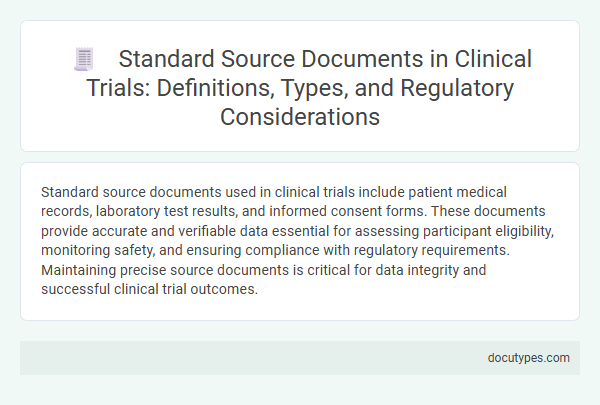Standard source documents used in clinical trials include patient medical records, laboratory test results, and informed consent forms. These documents provide accurate and verifiable data essential for assessing participant eligibility, monitoring safety, and ensuring compliance with regulatory requirements. Maintaining precise source documents is critical for data integrity and successful clinical trial outcomes.
Introduction to Standard Source Documents in Clinical Trials
What are the standard source documents used in clinical trials? Standard source documents are essential records that capture original data collected during a clinical trial. They provide a verified and accurate foundation for data analysis and regulatory review.
Definition and Importance of Source Documents
Source documents in clinical trials are original records containing data about the patient and the trial's conduct. They include medical records, laboratory reports, and consent forms that verify accuracy and integrity of trial information. You rely on these documents to ensure the trial's compliance with regulatory standards and protect participant safety.
Regulatory Framework Guiding Source Documents
Source documents in clinical trials are original records containing raw data gathered during the study. These documents serve as the foundation for verifying the accuracy and integrity of trial results.
The regulatory framework guiding source documents includes guidelines from the International Council for Harmonisation (ICH) and regulations from agencies like the FDA and EMA. Your adherence to these standards ensures compliance, data reliability, and participant safety throughout the clinical trial process.
Types of Source Documents Used in Clinical Trials
Source documents are critical records used in clinical trials to verify the accuracy of data collected during the study. These documents serve as the original evidence for patient information and trial activities.
Common types of source documents include patient medical records, laboratory test reports, and informed consent forms. Detailed case report forms (CRFs) and appointment logs are also essential for tracking trial progress. You must ensure these documents are accurate and properly maintained to comply with regulatory standards.
Electronic vs. Paper Source Documents
Standard source documents in clinical trials provide verified evidence of participant data collected during the study. Distinguishing between electronic and paper source documents ensures data integrity, compliance, and accessibility throughout the trial process.
- Paper Source Documents - Traditional handwritten or printed records such as case report forms, laboratory reports, and patient diaries serve as tangible evidence of clinical data.
- Electronic Source Documents - Digital records stored in electronic health records (EHRs), electronic case report forms (eCRFs), and clinical data management systems facilitate efficient data capture and remote access.
- Compliance and Security - Both electronic and paper sources must comply with regulatory standards like FDA 21 CFR Part 11, ensuring data authenticity, confidentiality, and traceability.
Essential Elements Required in Source Documentation
| Standard Source Documents | Essential Elements Required in Source Documentation |
|---|---|
| Patient Medical Records |
|
| Laboratory Reports |
|
| Imaging and Radiology Reports |
|
| Informed Consent Forms |
|
| Case Report Forms (CRF) |
|
| Drug Accountability Logs |
|
| Vital Signs and Physical Exam Records |
|
Understanding these essential elements in source documentation helps ensure Your clinical trial data is complete, accurate, and compliant with regulatory standards.
Best Practices for Maintaining Source Document Integrity
Source documents are essential records that provide the original data for clinical trials, ensuring accuracy and traceability. Maintaining their integrity is crucial for regulatory compliance and valid study results.
- Original Medical Records - These include patient charts, lab reports, and imaging results, serving as primary evidence of clinical observations and interventions.
- Case Report Forms (CRFs) - Transcriptions of source data that must be accurate and verifiable against original documents to ensure data reliability.
- Best Practices for Integrity - Implement secure access controls, regular audits, and clear documentation protocols to prevent data alteration or loss during the trial.
Common Compliance Issues and How to Address Them
Standard source documents are essential for maintaining data integrity in clinical trials. Common compliance issues often arise from incomplete or inaccurate source documentation.
- Electronic Health Records (EHRs) - Digital versions of patient health information must be regularly verified for accuracy and completeness to comply with regulatory standards.
- Case Report Forms (CRFs) - These documents require precise and timely data entry to avoid discrepancies between source data and reported outcomes.
- Informed Consent Forms (ICFs) - Proper documentation of patient consent ensures ethical compliance and protects participant rights.
You should implement rigorous quality control measures and staff training to address frequent compliance challenges in clinical trial documentation.
Source Document Retention and Archiving Requirements
Standard source documents in clinical trials include patient medical records, laboratory reports, and informed consent forms. These documents provide critical evidence to verify data accuracy and ensure regulatory compliance throughout the study.
Source document retention mandates maintaining records for a minimum of 2 to 15 years, depending on regulatory authority and study type. Proper archiving involves secure, organized storage with controlled access to preserve data integrity and facilitate audits or inspections.
What Are the Standard Source Documents Used in Clinical Trials? Infographic

